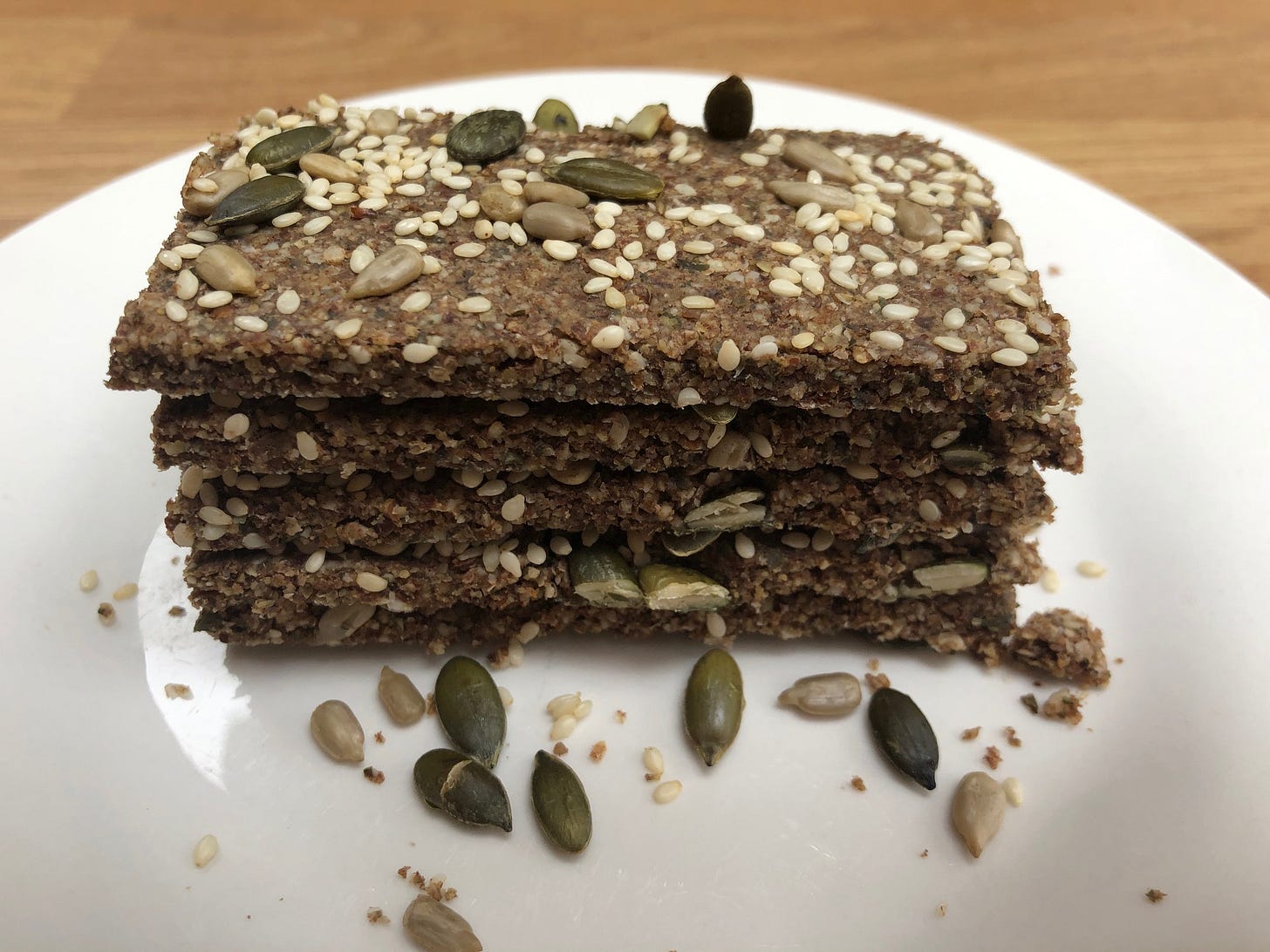Buzzing: Safety first!
Howdy all, how are you doing this week? I am very excited to report that today, I am going to collect my first batch of brewer’s spent grain from a local brewery to feed to my mealworms. This is circularity in action!
This week in Buzzing:
Is it safe to eat insects? (spoiler: yes)
The Q&A: Rachel O’Connor, Michelmores
Test Corner: Crickety crackers
I want to talk about whether it is safe to eat insects because it is at the heart of people’s aversion to eating them. The “yuck factor” is basically a reaction to a lack of familiarity and the perceived risk that eating insects might make you ill.
I’ll start with the broad-brush statement that the 2,000 or so edible insect species are safe to eat: if it weren’t so, 2 billion people would not do so on a regular basis. However, there are some genuine risks. Insect allergies for instance are well documented: people who are allergic to seafood or dust mites are likely to be allergic to insects too.
People often ask about venomous critters such as scorpions or spiders (which are arachnids, not insects) or even hornets. You’ll be glad to hear that it is safe to eat the sting and that venom is denatured in the cooking or fermentation process (full disclaimer: this “reassurance” is unlikely to ever convince me to eat a scorpion, but that’s just me). In fact, hornet venom is what gives Japan’s hornet liquor its distinctive flavour and colour: live hornets are plunged into a clear liquor called Shochu, and in their death throes, they release their venom into the liquor.
Insects that are foraged in the wild may be contaminated with pesticides. Dr Chrysantus Tanga at ICIPE in Kenya told me last year that many people had contacted ICIPE during the locust plague to ask whether it was safe to eat the locusts; ICIPE had advised against doing so in areas where there had been spraying (one of the measures used to kill the swarms).
There are other, more prosaic risks associated with eating insects however, which are much the same as eating any other type of food, such as the presence of pathogens like listeria or salmonella, or mycotoxins. These usually happen because of poor hygiene or improper storage.
Dr Tanga and his team actually ran food contamination tests on grasshoppers sold from market vendors and street stalls in Uganda and found quite a toxic soup, which you would expect from most foods sold in poor hygiene conditions.
Fortunately these risks can be overcome by rigorous hygiene standards along the food chain. ICIPE has developed food safety standards in East Africa to show how to safely process edible insects.
Entotrust has also developed an independent certification system to guarantee the high quality and safety of products containing edible insects. It follows a farm-to-fork approach, assessing products from ingredient to finished product. Several well-known producers in Europe and North America such as Entomo Farms, Merci Mercado and Minus Farm have already obtained their certification, as well as the Burkinabe company FasoPro, which produces shea-tree caterpillars.
Interestingly, Entotrust is currently in the process of running a worldwide insect food survey where insect companies are invited to send their samples for microbiological analysis. The collated data will then be used to demonstrate that insects are a reliable alternative source of protein.
It may sound incredibly boring to most of us, but this is God’s work for an industry in its infancy: consumers really need to be reassured that insects are safe to eat if they are to be taken seriously as a food source. Just imagine the headlines if it went wrong: “Crickets Kill!!”, “Toxic Mealworms Poisoned Family”, you get the picture. I am not suggesting this is likely to happen, just that the reputational damage could undo the last 10 years of work in an instant. So I really salute Entotrust’s initiative and the hard work of insect companies to build trust in the sector.
The Q&A: Rachel O’Connor, Senior Associate at Michelmores
This week, I bring you words of wisdom from agricultural lawyer Rachel O’Connor. I contacted Rachel in the hope she would enlighten me on post-Brexit insect regulation shenanigans. She did, but I’ll spare you the details. Instead I thought I’d share with you nuggets from our conversation in which her passion for sustainable farming, and her conviction that insect protein is part of the solution, shine through. Rachel’s father is an entomologist, which is how she came across insect protein in the first place. She and Partner Ben Sharples spearhead the Sustainable Agriculture initiative at Michelmores, which has the largest team of agricultural solicitors in the country.
How did an agricultural lawyer become interested in insect protein for animal feed?
We have had this huge drive towards productivity since WW2 that has played a big part in undermining agriculture’s historic symbiotic relationship with nature. This was predominantly policy-driven, with huge pressure on our farmers to increase volume whilst producing low-cost food. In the process, we lost insects as pollinators, we lost wildlife. Now we are having to re-learn how to farm and produce food without destroying the foundations of our food chain.
Insects are the link between what happens at one end of the chain and how we start a new one: we must harness their ability to turn what’s otherwise organic waste into high-quality protein and start that food chain again. When I understood that, I thought it had huge potential to alter our production of meat in particular, in a positive way.
What do you make of the idea of using lower-grade substrates [the feed of the insects] such as catering waste or manure?
The UK is a leader in animal welfare and food standards; we should not be seeking to undermine that. I think if we can access enough safe substrates [such as pre-consumer by-products], with the support of scientific research to demonstrate safety across the food chain, that will be a significant development for the industry. It may not be necessary or appropriate to resort to manure or other low value waste, which many consumers would not be comfortable with. We could then continue to produce the highest-quality meat in the world, sustainably, and sell it on that basis. We must reconnect with the value of food, how much it costs to produce and what you pay for it.
Is there an opportunity for traditional farming?
Insect protein production offers the prospect of short supply chains, where you use products from the farm to create new protein. It is such an attractive, circular way of enhancing aspects of farming practices. Also, with the phasing out of subsidies under the new Agriculture Act 2020 [which came into force last November in advance of Brexit], it is anticipated that there will be a significant gap in funding for most farmers and it’s a great opportunity for them to connect with entrepreneurs in this field – whether it be leasing old farm buildings or using a waste heat source for insect farming or vertical farming.
Test Corner: Crickety crackers
Instar Farming’s cricket powder has been a revelation. Since buying it, I’ve used it in smoothies and blissballs and really enjoyed its fine texture and nutty flavour. This week, I wanted to try it cooked, because this is where I’ve not enjoyed crickets in the past.
So I made a batch of crackers. The original recipe is basically all seeds and a little bit of water, so I thought substituting 30g of seeds for cricket powder would work nicely. The flavour was lovely: I could definitely discern the crickets, nutty and earthy, but it wasn’t overwhelming and had no overtones of liver, which I dreaded after the cricket burger fiasco.
The only downside was that they were a little too soft. The original recipe is quite soft already – something akin to an oat cake rather than a Ryvita – but my adaptation made it even more so. It should be relatively easy to fix by upping the content of the flaxseeds (a natural binding agent) by 20-30g and reducing the cricket/seed quantities accordingly.
I served the crackers to the kids for dinner, with a bowl of hummus, chopped veg and some nice cheese. My daughter loved them, my son so so.
So here is the recipe. It is endlessly customisable (change the seeds mix/spices, try herbs instead etc). Oh and it takes about 10 min to make 😊
· 50g flaxseeds
· 120g mix of seeds (sunflower, pumpkin, sesame, poppy etc)
· 3 tbsp mixed seeds for the topping
· 30g cricket powder
· ½ tsp salt
· ½ tsp cumin
Put all the ingredients in the food processor (except the 3tbsp for the topping) and blend to a powder. Add 60ml of water and turn into a rough dough. Roll out between two sheets of baking paper to a thickness of 1-2mm. Sprinkle the seeds topping, press into the dough. Pre-cut the crackers to the desired size with a pizza wheel or a large knife. Bake for 25 min at 150C.
Hi, I’m Emilie Filou, a freelance journalist. I specialise in business and sustainability issues and have a long-standing interest in Africa. If you liked Buzzing, please share with friends and colleagues, or buy me a coffee. The artwork in Buzzing was designed by Sheila Lukeni.





